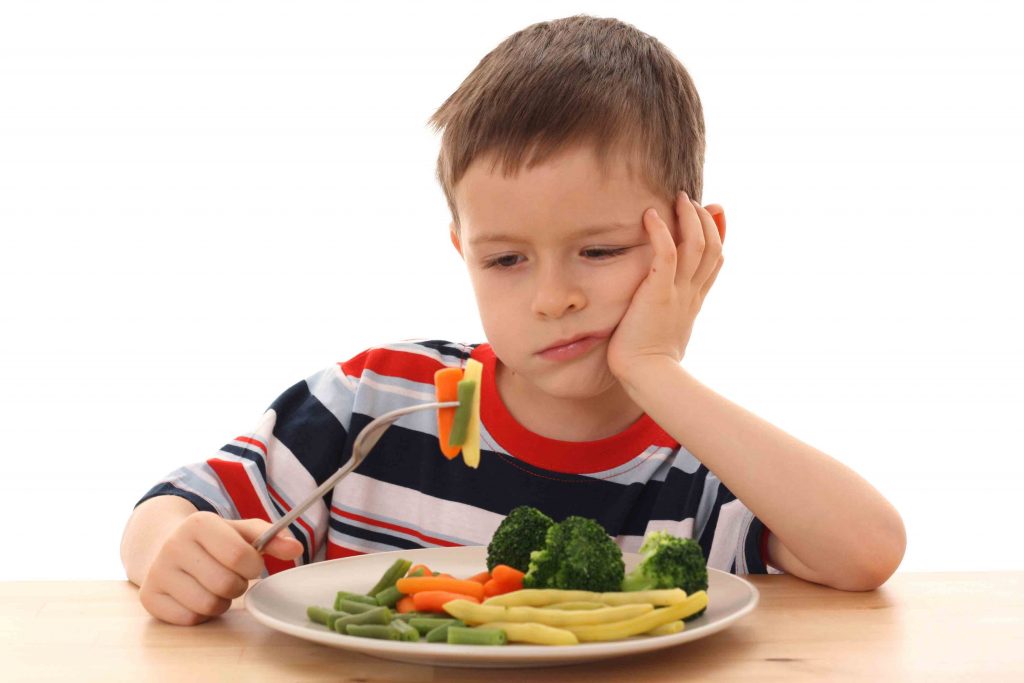Growing up with food allergies, Parents’ Voice Steering Committee member Rachel has long been interested in food and nutrition. As a mother of three young children she feels it’s more complex than ever navigating the labels, claims and marketing for food, and believes Parents’ Voice plays a vital role in informing and empowering parents to make healthier choices for their kids. Her article provides tips on how parents can encourage their children to eat more vegetables. 
I’m not the first to concede how tough it is to encourage kids to eat more vegetables. Two serves of fruit? No problem. One of my daughters could eat apples until the cows came home; another has been known to put away three bananas before breakfast; and my son and his father practically throw a party when it’s stone fruit season. But five servings of vegetables a day, as the Australian Dietary Guidelines recommend? Now that can be a battle.
It’s not uncommon for kids to turn their nose up at anything green. Sometimes they’ll eat one or two types of vegetables, but nothing else. For example, it’s not rare for toddlers to consume so much pumpkin and sweet potato that their skin glows orange. I even know of a child who would only eat white foods. Needless to say the celeriac and peeled radishes her mother prepared, to break the monotony of cauliflower and potato, didn’t pass the test. Another friend’s partner refuses to eat vegetables too, making it extra difficult to convince her kids that eating vegetables is vital for good health. Many other kids simply refuse vegetables, period.
Over the past ten years, I’ve built an arsenal of sure-fire techniques to ensure my family consumes more vegetables, not including the ones I sneak into every bolognese, sausage roll, pie, pasta sauce and casserole (which is a completely valid tactic, in my view).
To help you fight the good fight, here’s a compilation of my top five tips:
- Make the most of school initiatives such as Crunch&Sip: This NSW Government initiative encourages primary school students to refuel on fruit, salad and vegetables, and drink water in the presence of their teachers, and I’ve no doubt there’s similar initiatives in other states. Rather than fruit, I send my kids to school with vegetables or a salad, with celery, carrot, cucumber (baby kukes), cherry tomatoes and snow peas. They’re certainly more likely to consume the raw vegetables when they’re hungry and their friends are eating similar foods.
- Let the kids choose the vegetables and let them prepare them: At the store, I’ll often send the kids to choose the vegetables themselves. Not only specific items already on the list, but vegetables they can pick independently, perhaps with the guidance of a colour. For instance, I’ll ask them to come back with two red vegetables, three green and one yellow. This encourages them to choose new and interesting items, which not only increases variety, but creates a sense of ownership and leads them to healthier choices. Letting them help prepare the vegetables also incentivises them to eat it, or at the very least, try it. If you’ve got the space and an adequate green thumb, growing your own vegetables can also be worthwhile.
- Prepare vegetables in different ways: It’s amazing how good zucchini tastes in spiral form as ‘zugghetti’, according to my children. I’ve also been known to cut steamed sweet potato and zucchini into stars and hearts for lunchboxes using a cookie cutter, although admittedly, this is quite labour intensive. In addition to shapes, different cooking methods can increase the appeal of vegetables. My family’s main example is the humble cauliflower, which becomes a popular dish when sliced or separated into florets and then roasted with a few cloves of garlic.
- Add fresh herbs: Fresh herbs not only make dishes taste yummy, but they’re full of goodness too. My family’s favourite herb-filled dishes are homemade pesto pasta (crammed full of basil), DIY Vietnamese rice paper rolls (to which the kids add oodles of coriander and mint), and flatbread wraps with a chopped parsley and tomato salad inside. While I don’t have much of a green thumb, I seem to manage the odd herb in a planter box from time to time, and the kids love cutting and picking the herbs to add to a meal.
- Vegetable plates before dinner: When my kids complain of hunger before dinner, while I’m still trying to prepare, I simply put out a plate of chopped raw vegetables. Much like Crunch&Sip, they’re more likely to eat the items if they’re ravenous and it’s the only available option. I’m also less likely to nag them to “eat three more mouthfuls of peas” if I know they’ve filled up on vegetables before dinner, which I’m sure even they can appreciate.
I’m always after new ideas for bringing more vegetables into my family’s diet, so I’d now love to hear what you do. Please post your suggestions in the comments below.




